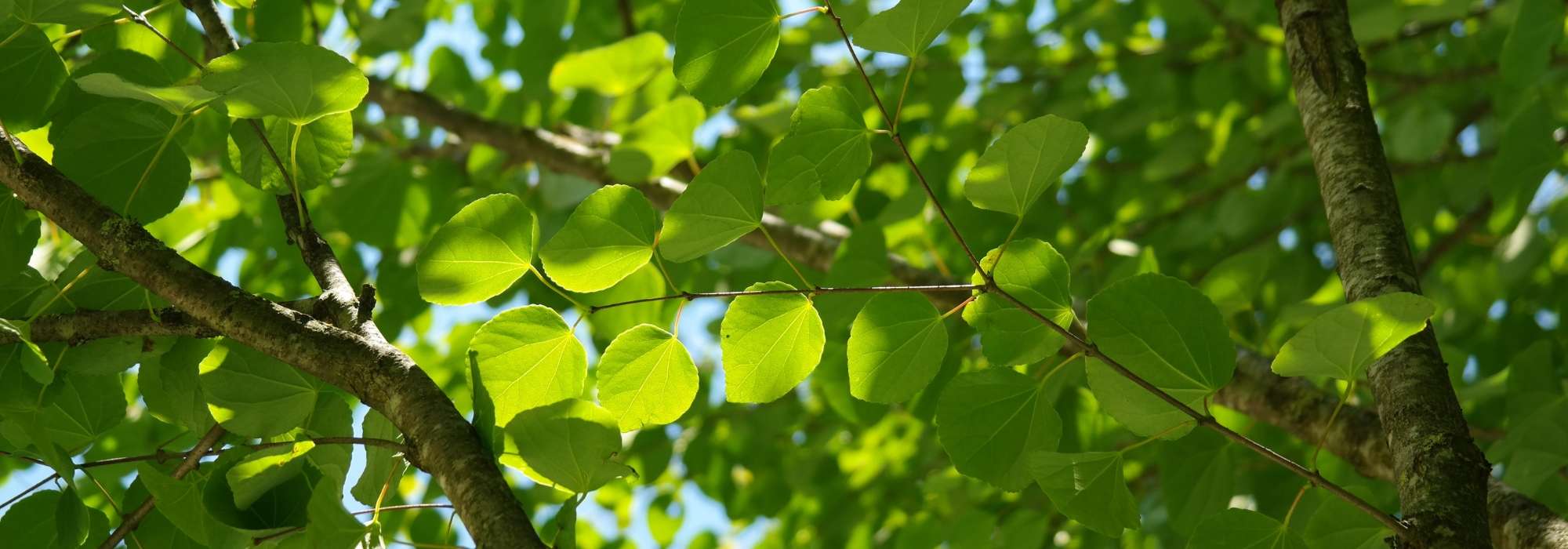
Caramel tree, Cercidiphyllum: planting, pruning and care
Summary
Cercidiphyllum, in a nutshell
- More commonly known as the caramel tree, Cercidiphyllum is a slender, very elegant small tree, famous for its caramel scent in autumn.
- Its small heart-shaped leaves, reminiscent of those of the Judas tree, declinate from soft purples in spring, gradually turning to bluish green in summer, before the autumn blaze.
- It thrives in humus-bearing, cool soils with a sunny or partially shaded exposure. Rather accommodating, it is acknowledged that a slightly acidic soil enhances its colours.
- There is a more compact form with pendulous branches (‘Pendula’) and a very original black-purple foliage form in spring (‘Rotfuchs’).
A word from our expert
Cercidiphyllum japonicum is a deciduous tree that measures no more than 12 to 15 m in our region, whereas it can easily reach 40 m in height with a trunk diameter of 4.50 m in its native habitat. Its name Cercidiphyllum refers to its heart-shaped leaves, reminiscent of those of the Judas tree, known as Cercis in Latin, with phyllum meaning leaf. However, it is rather its vernacular name “caramel tree” or “cake tree” that explains the subject’s popularity. Its most remarkable feature is indeed the aromas of its ochre-pink foliage in autumn, which authentically evoke those of gingerbread or caramel! The scents ebb and flow, intensifying when the atmosphere becomes misty.
The silhouette of the tree often features multiple trunks that develop slightly trailing horizontal branching. The interest also lies in the colour of the foliage, which appears reddish-pink in spring before turning green, then which declinates into shades of yellow, pink-orange, and purple in October, varying according to the clones.
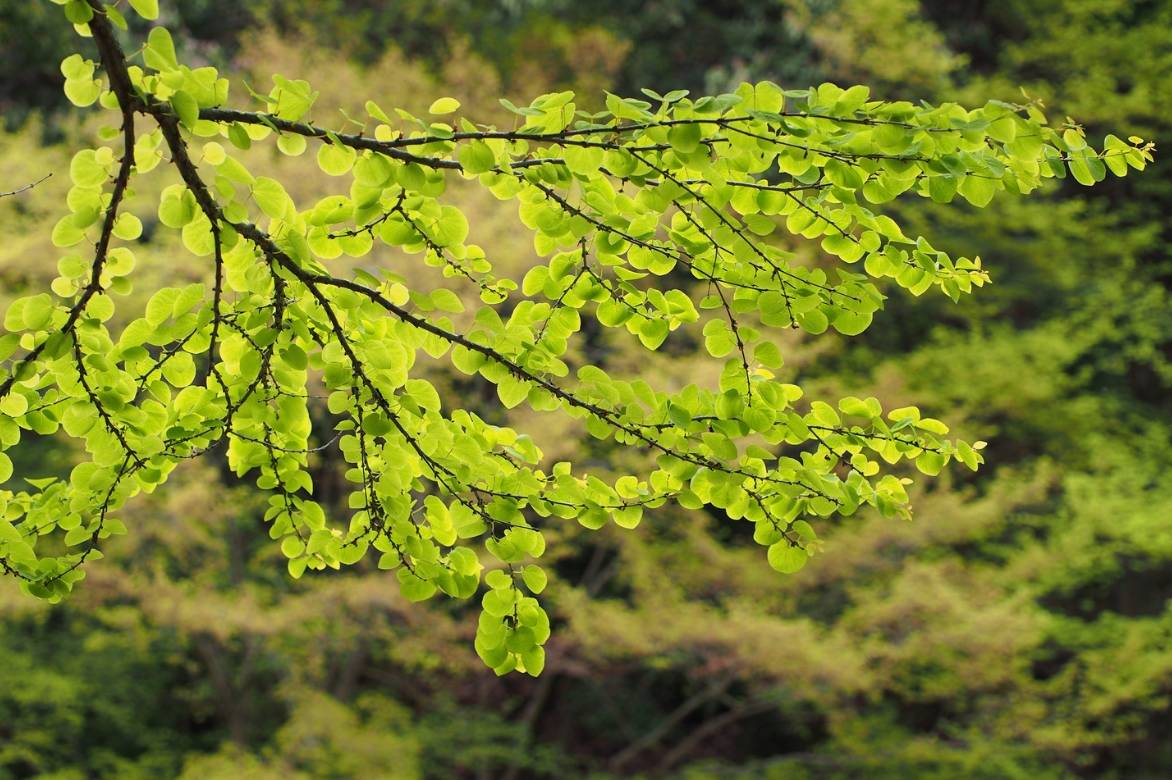
When the leaves of the caramel tree play with the light (photo harum koh-flickr)
Its flowering, quite insignificant, occurs in April, before the leaves, in the form of small flowers reduced to male and female sexual organs on distinct trees. The fruits are bean-shaped, measuring 1.5 to 5 cm in length.
The Cercidiphyllum fears only one thing: soil dryness, which causes its leaves to fall prematurely. Plant it in fresh soil, with an addition of potting soil or heather soil, near a bank if summers are hot or under the shade of a large tree, sheltered from cold or drying winds. Avoid planting it to the east, as the morning temperature contrast may damage the buds. It tolerates a pH of up to 8, but its colours are more beautiful in acidic soil (pH<7).
Description and botany
Botanical data sheet
- Latin name Cercidiphyllum
- Family Cercidiphyllaceae
- Common names Caramel tree, Katsura
- Flowering March-April
- Height 6 to 12 m
- Sun exposure sun or partial shade
- Soil type any loose, fresh and well-drained soil, even calcareous
- Hardiness Good (-20 °C)
The Cercidiphyllum japonicum, known as “Katsura” in Japanese, is the only species of this genus, which in fact constitutes the entire family of Cercidiphyllaceae. Although it is closely related to the primitive family of Magnoliaceae, the dull red filamentous flowering is insignificant and occurs on distinct male and female specimens.
The caramel tree, which thrives in China, Korea, and Japan, is regarded as the largest of the native deciduous trees, with trunks sometimes reaching 40 m in height and 4.5 m in diameter! Paradoxically, its introduction to the West from Japan in 1881 resulted in trees that are rather modest, rarely exceeding 8 to 10 m in height and 3 to 6 m in spread. They have the advantage of being able to fit into small gardens where a Japanese atmosphere is desired, imbued with delightful scents!
The straight trunk, often multiple, divides into a narrow fork that sometimes starts quite low, bearing a tier of fine horizontal branches with elegantly drooping tips. The slender stems, lacking a terminal bud, are adorned with small buds measuring 2 to 4 mm with 2 scales. The bark flakes off in long plates of a dull grey-brown that quickly develops some superficial wrinkles.
The weeping version of the caramel tree, Cercidiphyllum japonicum ‘Pendulum’, is even smaller, reaching a height of 6 m with a spread of 5 m. Its uniqueness also lies in its more spreading habit, filled with grace and poetry.
Carried by a thin petiole that is light green or reddish, the simple foliage is almost opposite on the new shoots and alternate on the dwarf branches that adorn the main branches. It is of rare beauty, displaying a range of attractive hues throughout the growing season. The modest dimensions of the lamina, measuring 5 to 10 cm wide, with finely crenate edges, add to its charm, especially as the radiating veins beautifully follow the heart-shaped lamina. Spring’s tender colours of a reddish-pink are followed by a glaucous green summer attire with a whitish underside that again draws attention in autumn with a symphony of yellows, oranges, pinks, and purples varying according to clones, soil quality, and temperatures. The larger, beautifully crenate leaves of Cercidiphyllum japonicum var. magnificum, endemic to Honshu Island, also display more vivid colours in autumn. Additionally, there is the delightful scent of melted caramel or gingerbread, perceptible only in autumn, especially at the end of a sunny day, which has contributed to its popularity. Occasionally, the foliage may suddenly dry out, turning directly from green to caramel brown due to lack of water during summer, but the scent becomes even more intense, especially when walking on the fallen leaves.
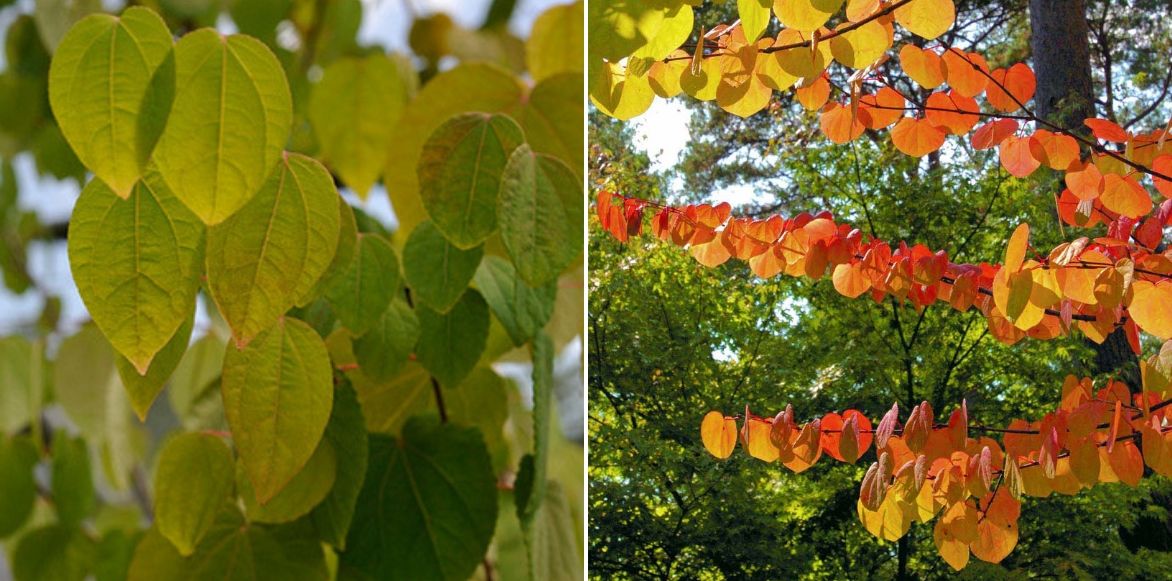
The foliage of the Cercidiphyllum japonicum turns purple and diffuses its caramel scent in autumn
The spring flowering, a somewhat dull pink-red, often goes unnoticed even though it appears on bare branches. Lacking petals, it consists either of small clusters of reddish stamens or pairs of pistils borne on dwarf branches.
The fruits, found only on female trees, are green pods measuring 2 cm long that contain thin, winged seeds.
Its dark brown, hard wood is valued for making board games such as the game of go in China.
You may also read
Japanese maple: planting, pruning and careThe main varieties of Cercidiphyllum
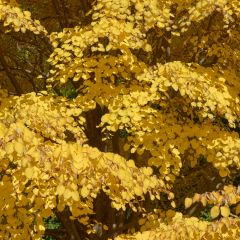
Cercidiphyllum japonicum
- Flowering time april, may
- Height at maturity 12 m
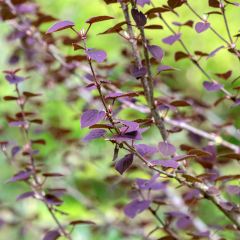
Cercidiphyllum japonicum Rotfuchs
- Flowering time april, may
- Height at maturity 4 m
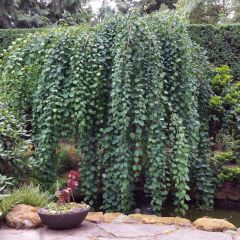
Cercidiphyllum japonicum Pendulum
- Flowering time april, may
- Height at maturity 6 m
Discover other Cercidiphyllum
View All →Available in 2 sizes
Available in 2 sizes
Available in 2 sizes
Available in 1 sizes
Available in 1 sizes
Available in 1 sizes
Available in 1 sizes
Available in 1 sizes
Planting Cercidiphyllum
Where to plant the caramel tree?
The Cercidiphyllum thrives in rich, deep, cool, humus-bearing soil, preferably acidic, but it can tolerate slightly calcareous soils, although the foliage colour will be less intense. It is sensitive to dry or poorly drained soils. Place it away from bushes or other plants as its roots are shallow and suffer from root competition.
It adapts to sunlight as well as partial shade but enjoys a cool atmosphere, for example, near a water feature. Avoid locations exposed to drying winds. Hardy down to -20°C, ensure it is placed in a sheltered spot from cold winds to protect its young shoots in spring, which can sometimes be damaged by late frosts.
Resistant to pollution, this tree deserves its place in small urban gardens with not too dry conditions.
When to plant?
Choose autumn or late winter (February-March) to plant it, especially if it is in bare roots, but in any case, this period allows it to establish itself deeply before facing the summer season.
How to plant?
This plant is easy to cultivate if it has sufficiently moist conditions. To plant it:
- Soak the root ball in a bucket of water to thoroughly moisten it.
- Dig a hole three times wider than the root ball and loosen the soil to a depth of 80 cm around it with a fork.
- Add a few handfuls of sand and gravel to ensure good drainage around the roots. In heavy soil, opt for planting on a mound or within a rock garden.
- Add manure or decomposed compost if the soil is sandy.
- Place the plant in the planting hole.
- Replace the soil and lightly firm it down.
- Water.
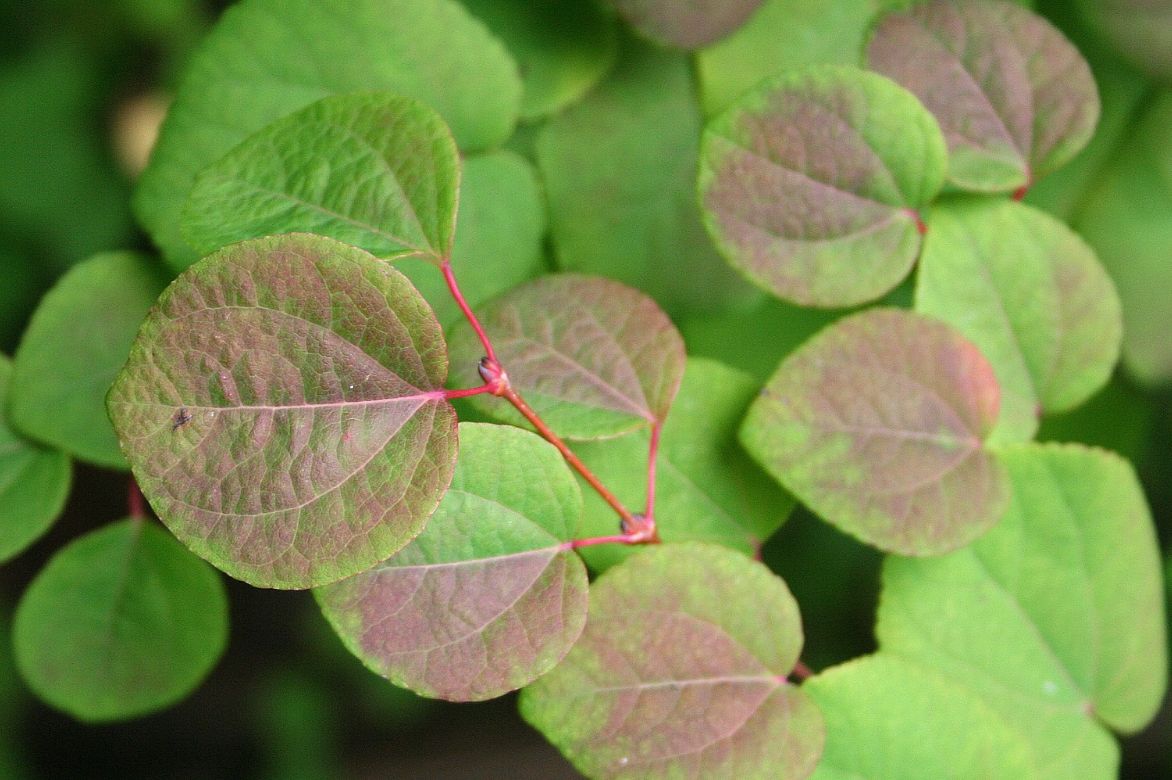
Beautiful foliage of Cercidiphyllum japonicum
Pruning and care
Once established, Cercidiphyllum requires no care.
Control watering for at least the first 2-3 years and ensure to mulch the base to keep the soil cool and in winter to protect the roots from the cold. Also protect the branches with horticultural fleece to prevent the buds from freezing when the young plant is still small.
The caramel tree is not susceptible to diseases or pests.
The tree does not require pruning unless you wish to maintain it as a single trunk: after the leaves have fallen, cut back the branching that forms at the base of the trunk, but no more than two per year.
→ Read also: Cercidiphyllum, Caramel Tree: how to prune it?
Multiplication
The simplest multiplication method involves propagation by cuttings in August.
Propagation by Cuttings
Prepare a deep pot by filling it with potting soil mixed with sand.
- Cut branches of 50 cm and then take a section of 15 cm from the area where the colour of the wood changes.
- Remove the leaves located near the base of the cutting.
- Sprinkle the base with plant hormone before inserting them into the substrate for 2/3 of their length, ensuring they do not touch each other.
- Gently firm the soil around to eliminate air pockets and ensure good contact between the potting soil and the cutting.
- Surround the pot with a transparent plastic bag secured around the pot with an elastic band. Place them outside in a shaded area. Keep them under a frame during winter.
- In autumn, separate the rooted cuttings and plant them in buckets, keeping them under a frame until spring.
- Plant your plants in spring in the ground.
→ Learn more in our tutorial: How to propagate the Caramel Tree?
Uses and associations
The Cercidiphyllum japonicum with its graceful silhouette and soft hues makes a remarkable specimen when planted alone on a beautiful short grass meadow, provided that the climate is sufficiently humid, as found along the Atlantic coast. Elsewhere, it is preferable to place it near a water feature or close to a large tree that filters the sunlight, such as a magnolia, a Liquidambar, or a Liriodendron, which have similar requirements.
Consider positioning it near a relaxation area or a pathway to fully enjoy its delightful fragrance.

An example of autumn association: Cercidiphyllum japonicum, Liquidambar styraciflua ‘Worplesdon’, Nyssa sylvatica, and Acer palmatum ‘Senkaki’ (‘Sangokaku’)
If you have a large space, create a flamboyant autumn scene and a flowering display in season by pairing it with a Liquidambar, a tupelo (Nyssa sylvatica), and a Japanese maple, planted at least 4 m apart, along with various shrubs such as Cornus kousa and florida, Amelanchiers, or Euonymus.
It tolerates the company of small low shrubs or perennials that evolve through the seasons, such as the lovely bushy Clematis heracleifolia with its small fragrant purple autumn flowers, a Lespedeza thunbergii with bright pink blooms, silver candles, lady’s mantle, corydalis, Asters, Chrysanthemum…
The weeping form ‘Pendula’ adds a romantic touch to the garden with its spreading and generously trailing habit. You can advantageously replace a weeping willow or a Sophora japonica ‘Pendula’ with this slow-growing small tree that reaches barely 6 m high and 5 m wide, boasting foliage with exceptional hues and fragrance. It will also find its place in the background of a flowerbed or within a country hedge, illuminating it with its vibrant colours and unique weeping habit. When paired with the Japanese maple, the tupelo, or the golden Catalpa, it will reveal its beauty in a symphony of colours.

Cercidiphyllum japonicum ‘Pendulum’ in situ / Stunning autumn colours of Cercidiphyllum japonicum
The Cercidiphyllum japonicum ‘Rotfuchs’, which is less vigorous than the species type, offers a dark purple hue in spring that adds a touch of mystery to the scene. It can be used as a specimen or in a light woodland setting.
→ Discover more association ideas with the Cercidiphyllum in our advice sheet!
Did you know?
Americans have made sweets from the leaves of Cercidiphyllum, which have been found to be potentially carcinogenic. The caramel tree first appeared in the United States in 1865 before reaching Europe in 1881. The variety Cercidiphyllum japonicum var. sinense, native to central and western China, reaches impressive heights of 40 m and grows on a single trunk. It was brought back from China in 1907 by Ernest Wilson. It is now endangered in its home country.
To go further
- Discover our range of Cercidiphyllum
- Discover our advice sheet on weeping habit trees
- How to choose a Caramel Tree or Cercidiphyllum? All our tips.
- Subscribe!
- Contents
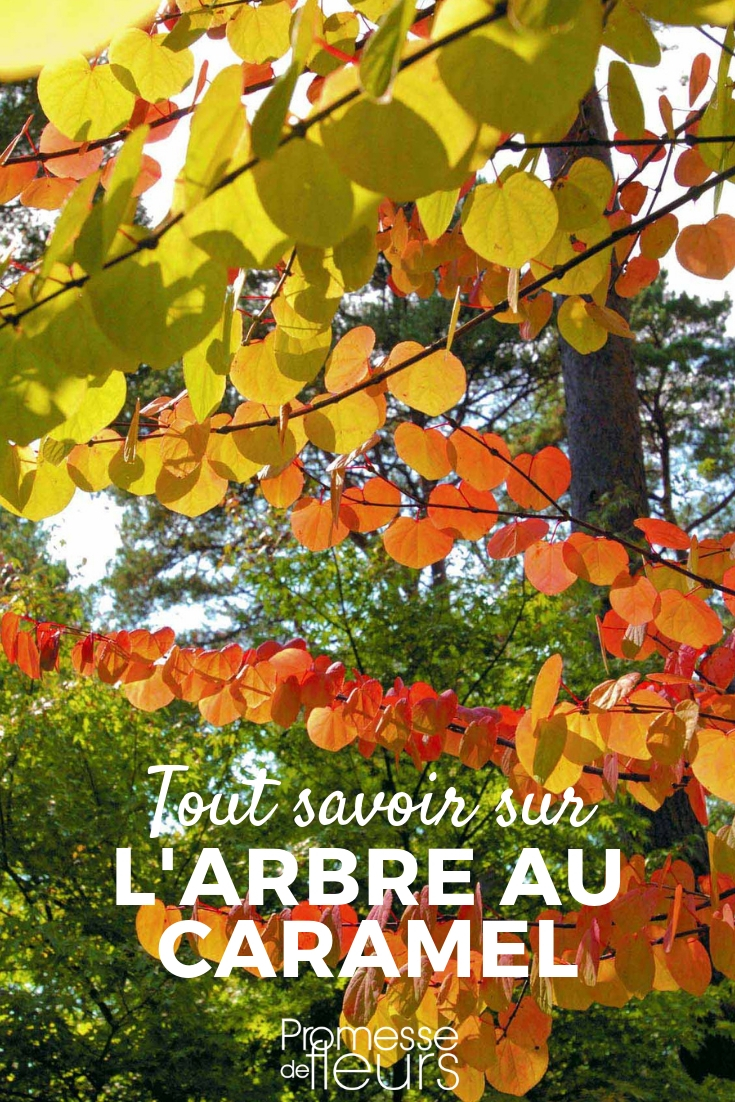


































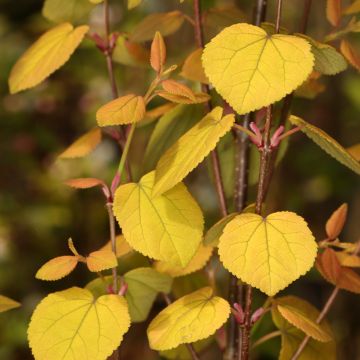
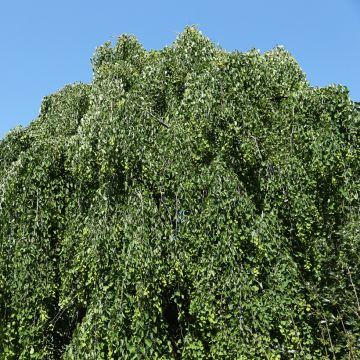
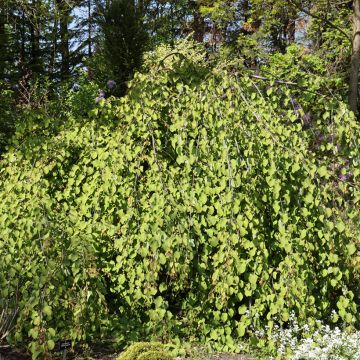
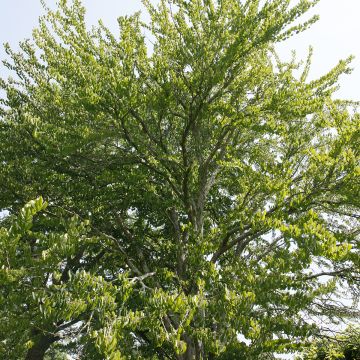
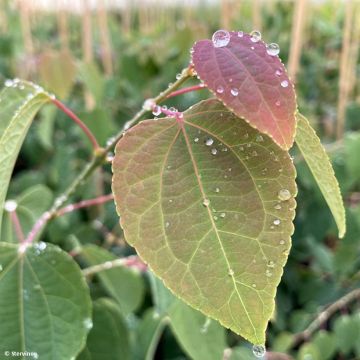
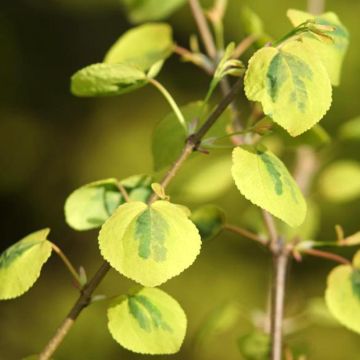
Feedbacks